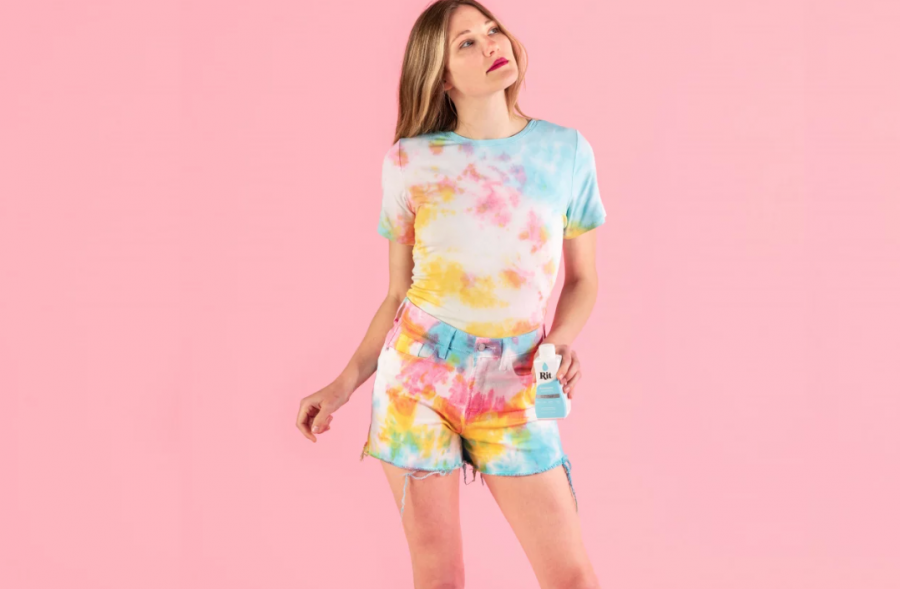2020’s Tie Dye Craze
The number of google searches for “tie-dye loungewear” has increased by 5,000% since last year. The volume of these different searches began to spike in March, around the same time worldwide quarantine and stay-at-home orders arose due to the covid-19 pandemic. The so-called “tie-dye trend” is gaining back its popularity and thus becoming a hot quarantine fashion trend that doesn’t seem to be going anywhere. This article is for those who are curious about the resurgence of this trend, unwinding and analyzing the sudden resurrection of colorful swirls and psychedelic patterns.
Tie-dye techniques date all the way back to the 6th century AD. With roots in India, Japan, Indonesia, and West Africa, it is one of the most ancient forms of decorating cloth. The trend, however, serves as a contemporary interpretation of the colorful style first seen in the mid-1960s in the United States. In essence, tie-dying consists of simply folding, twisting, pleating, or crumpling fabric, then binding it with string or rubber bands, and finally applying a variety of dyes. Tie-dye has been setting its roots in runways last year. When scrolling down one’s Instagram feed it is clear tie-dye sets and loungewear are everywhere, taking their stance as the culmination of “quarantine fashion”.
When looking at it from one perspective, quarantine has left us all trapped at home, resulting in unusual amounts of free time. While some choose to bake or read, others pick inexpensive crafts as their tool to combat boredom. With its simple yet multi-step process, tie-dyeing is the perfect pass-time. In fact, at Graded, several sophomores have expressed how they’ve embraced the trend as a hobby and entertaining project. They’ve also manifested that experimenting with this technique brought them joy. In stressful times, detaching and focusing on an activity that stimulates joyful experiences is a necessity, making tie-dying the perfect social distancing distraction, not to mention, it looks good!
During times of crisis, it is critical to prioritize mental health. Scientific publications have indicated that the reason for tie dye’s popularity is it embraces nostalgia, which is good for our mental health. According to Dr. Clay Routledge, a professor of psychology at North Dakota State University, nostalgia has mood-boosting effects, drawing security and comfort from the past. He adds how “nostalgia doesn’t just make people feel happier. It makes them feel more connected, energized, and motivated.” In our current situation, it is easy to understand the need for these emotions. Tie-dye patterns are comforting, reminding the ‘artists’ of the carfree sensations felt by Americans in the late ’60s and early ’70s about. They also appeal to the already established “vintage” or “throwback” trends. Any activity that sparks a degree of happiness is a worthy endeavor.
Perhaps, the fact that tie-dye is all over the place is because of how accessible it is. The technique involves a few cheap materials, a simple process, and lots of social media inspiration, making this the perfect distraction over quarantine.
Tie-dye has also been a gateway towards more sustainable shopping; buying secondhand or even reinventing/reusing clothes. “It is a way of recycling/upcycling clothes I no longer use, want, or like,” states a sophomore at Graded. Why not make your own and follow the trend? It is cheap and easy.
The tie-dying technique was first seen as a symbol of rejection to strict social norms imposed on society, rejecting violence, capitalism, materialism, and uniformity. It transcended socioeconomic status, allowing anyone to join in the movement when creating their own symbols of peace and embracing the hippie culture.
Today, the meaning of tie-dye has shifted from social rebellion to a fashion trend. Nonetheless, many believe that the comeback of the trend was due to the clear political and social parallels to be made with the 1960s in relation to today. “In the Trump era when right-wing politics is so loud, I think tie-dye can be viewed as a peaceful, but defiant protest against conservatives,” claimed Chris Leba, R13 denim founder. As stated by Florence Allday, a beauty and fashion research analyst at Euromonitor, “tie-dye signifies putting the trauma of recent events behind us.”
Fashion has always been cyclical, meaning that trends will come and go. Tie-dying has had its glory in the 60s and is resurging today for other motives: simplicity, time consumption, mental health, popularity, and politics.
Sources: Oprah Magazine, Business Insider, Heroine

As a first year “Talonista”, Letícia finds her way into the features section. If we were back at the Graded halls, Letícia could be seen struggling...









